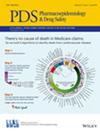A Two‐Step Framework for Validating Causal Effect Estimates
IF 2.4
4区 医学
Q3 PHARMACOLOGY & PHARMACY
引用次数: 0
Abstract
Background: Comparing causal effect estimates obtained using observational data to those obtained from the gold standard (i.e., randomized controlled trials [RCTs]) helps assess the validity of these estimates. However, comparisons are challenging due to differences between observational data and RCT generated data. The unknown验证因果效应估计值的两步框架
背景:将使用观察数据获得的因果效应估计值与黄金标准(即随机对照试验 [RCT])获得的估计值进行比较,有助于评估这些估计值的有效性。然而,由于观察数据与随机对照试验产生的数据之间存在差异,因此比较具有挑战性。观察数据中未知的治疗分配机制和 RCT 与观察数据之间不同的抽样机制会分别导致混杂和抽样偏差。研究目的:本研究旨在提出一个两步框架,通过调整这两种机制来验证从观察数据中获得的因果效应估计值:构建与两种机制相关的因果效应估计值。根据该估计器推导出比较因果效应估计值的两步框架。为在实践中实施该框架,开发了一个 RCTrep 软件包:进行了一项模拟研究,表明使用我们的框架,观察数据可以产生与 RCT 类似的因果效应估计值。结果:一项模拟研究表明,利用我们的框架,观察数据可以得出与 RCT 类似的因果效应估计值。该框架在现实世界中的应用,验证了从登记数据中获得的辅助化疗的治疗效果:本研究构建了一个框架,用于比较观察数据和 RCT 数据之间的因果效应估计值,有助于评估从观察数据中获得的因果效应估计值的有效性。
本文章由计算机程序翻译,如有差异,请以英文原文为准。
求助全文
约1分钟内获得全文
求助全文
来源期刊
CiteScore
4.80
自引率
7.70%
发文量
173
审稿时长
3 months
期刊介绍:
The aim of Pharmacoepidemiology and Drug Safety is to provide an international forum for the communication and evaluation of data, methods and opinion in the discipline of pharmacoepidemiology. The Journal publishes peer-reviewed reports of original research, invited reviews and a variety of guest editorials and commentaries embracing scientific, medical, statistical, legal and economic aspects of pharmacoepidemiology and post-marketing surveillance of drug safety. Appropriate material in these categories may also be considered for publication as a Brief Report.
Particular areas of interest include:
design, analysis, results, and interpretation of studies looking at the benefit or safety of specific pharmaceuticals, biologics, or medical devices, including studies in pharmacovigilance, postmarketing surveillance, pharmacoeconomics, patient safety, molecular pharmacoepidemiology, or any other study within the broad field of pharmacoepidemiology;
comparative effectiveness research relating to pharmaceuticals, biologics, and medical devices. Comparative effectiveness research is the generation and synthesis of evidence that compares the benefits and harms of alternative methods to prevent, diagnose, treat, and monitor a clinical condition, as these methods are truly used in the real world;
methodologic contributions of relevance to pharmacoepidemiology, whether original contributions, reviews of existing methods, or tutorials for how to apply the methods of pharmacoepidemiology;
assessments of harm versus benefit in drug therapy;
patterns of drug utilization;
relationships between pharmacoepidemiology and the formulation and interpretation of regulatory guidelines;
evaluations of risk management plans and programmes relating to pharmaceuticals, biologics and medical devices.

 求助内容:
求助内容: 应助结果提醒方式:
应助结果提醒方式:


